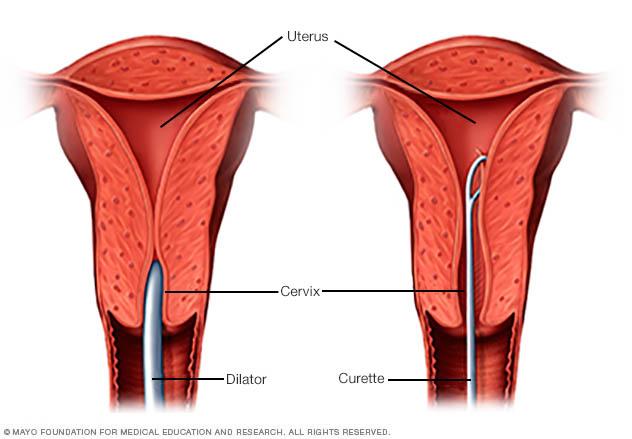Dilatación y curetaje (D&C)

Dilation and Curettage (D&C)

Introduction
Dilation and curettage (D&C) is a fairly common, minor surgical procedure. D&Cs are used to remove the lining of the uterus. A D&C may be performed to obtain tissue samples to diagnose a condition, treat irregular or heavy bleeding, remove fetal and placental tissue following a miscarriage, and as an infrequently used abortion method. D&Cs are usually outpatient procedures and are associated with a short recovery time.
A D&C may be recommended for several conditions including bleeding between periods, heavy menstrual flow, postmenopausal bleeding, or abnormal bleeding while taking hormone replacement therapy. It may be used to treat the uterine lining growth from polycystic ovary syndrome. A D&C is used to remove endometrial polyps and precancerous cells. Following a miscarriage or “missed” miscarriage, a D&C is used to remove fetal and placental tissue.
Treatment
A D&C is usually performed as a short outpatient procedure at a surgical center or hospital. You may receive general or local anesthesia. You should arrange to have someone else drive you home following your surgery.
For the procedure, you will lie on your back on an exam table. Your feet will be placed in stirrups to position your pelvis. Your doctor will gently insert a speculum to open the walls of your vagina. Another device is used to open and widen your cervix to allow your doctor to access your uterus. You doctor will insert the curette through your vagina, cervix, and into your uterus. A curette is a long thin instrument with a loop on the end. Your doctor will used the curette to remove the inner lining of your uterus and collect the tissue for examination.
You may resume your regular activities usually within a day or two of your procedure. You may experience cramps, back pain, and bleeding for a few days. Your doctor will recommend or prescribe pain medication. Your doctor will provide you with specific instructions and restrictions following your D&C.
D&C stands for “dilatation and curettage”, a procedure in which your doctor dilates or opens the cervix and scrapes the lining of the uterus. A D&C is often performed in cases of heavy, abnormal uterine bleeding, only for diagnostic and not for therapeutic purposes.
A D&C is often performed after a hysteroscopy where the doctor uses a hysteroscope to inspect the uterine cavity for visible growths and abnormalities. A pathologist examines cells from the uterine lining under a microscope to determine the cause of abnormal bleeding, such as polyps, fibroids, hyperplasia, cancer or precancer.
A D&C may provide temporary relief from heavy bleeding.
References
- Dilation and Curettage. EMedicineHealth. 2007. www.emedicinehealth.com/dilation_and_curettage_dandc/article_em.htm
- Parker WH. A Gynecologist’s Second Opinion. (c) 2003; A Plume Book; Published by the Penguin Group, New York, NY.